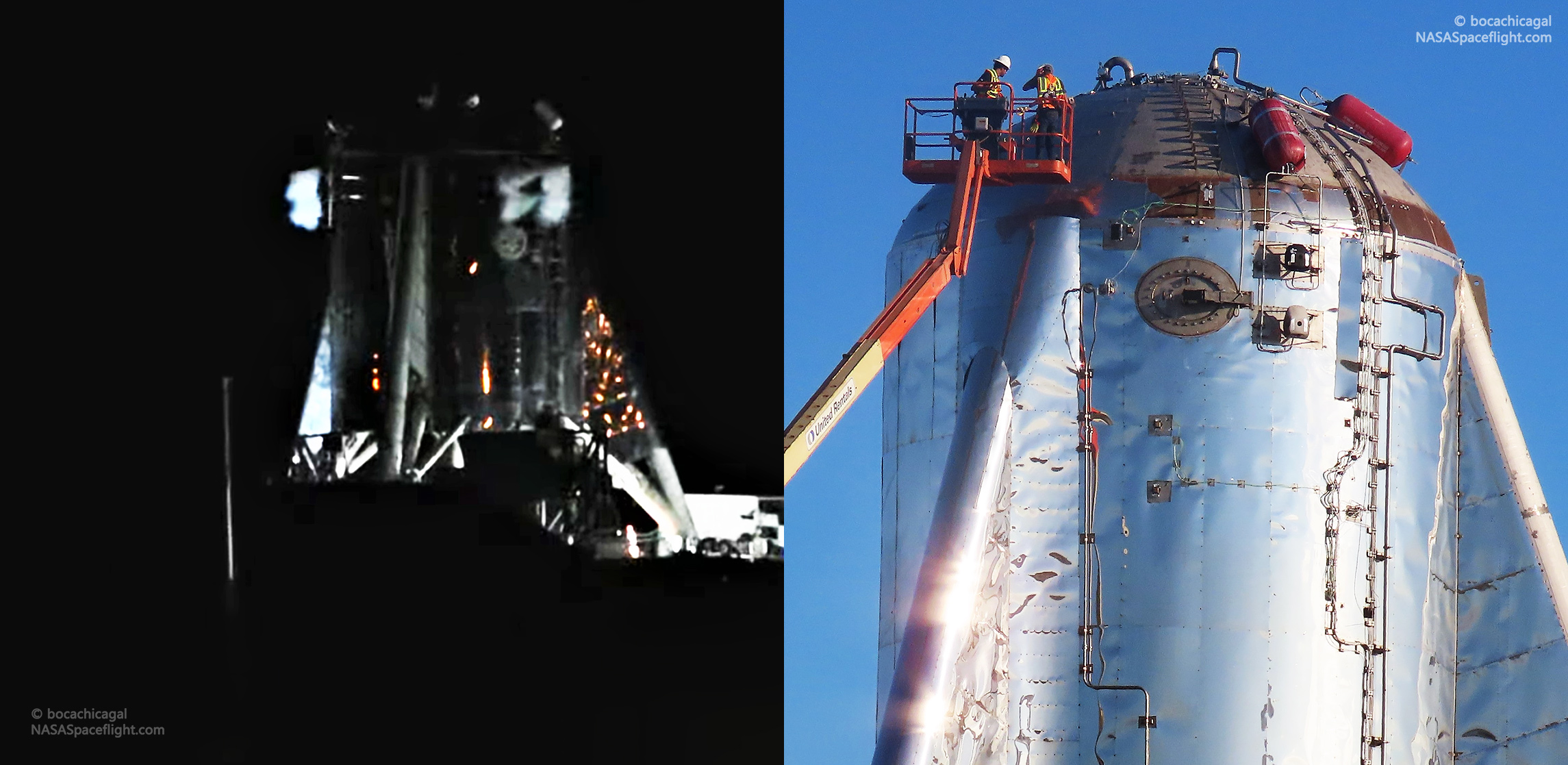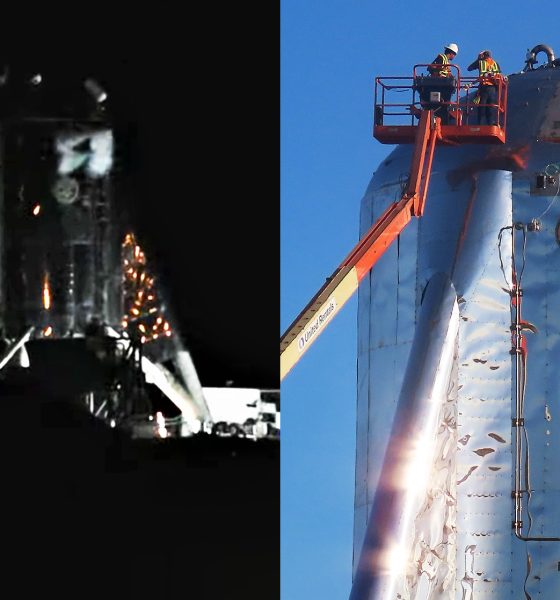

News
SpaceX tests Starhopper’s maneuvering thrusters ahead of inaugural flight test
Late at night on July 22nd, SpaceX’s South Texas team of technicians and engineers were busy testing a small but critical component of Starhopper, a testbed and low-fidelity Starship prototype meant to attempt its first untethered flight test as early as July 24th.
Monday evening’s testing centered around Starhopper’s cold gas nitrogen thrusters, multi-nozzle assemblies that appear to have quite literally been taken off of flight-proven Falcon 9 boosters. For Starhopper, they will act in a similar – albeit significantly reduced – fashion, serving to control the giant steel prototype’s attitude and augment its lone Raptor engine’s own thrust vectoring (i.e. steering) capability.
Although SpaceX has never released official numbers for the thrust of the cold gas thrusters used on Falcon 9 boosters and upper stages, it’s safe to say from their performance that the low-efficiency nitrogen thrusters produce roughly 5 kN (~1100 lbf) of thrust, perhaps up to 10+ kN. For an almost empty Falcon 9 booster, this translates to extremely rapid (sub-10s) flip maneuvers during return-to-launch-site (RTLS) landings.
At the same time, Falcon boosters have two sizes of cold-gas thrusters, with much larger high-performance (>10 kN) pods – located on the larger of the booster’s two raceways – focused on settling the rocket’s propellant after recovery-related coast periods. A duo of smaller 3-axis pods situated on the outside of the interstage serve as true attitude control system (ACS) thrusters, precisely pointing, flipping, and orienting boosters during vacuum operations and partially augmenting grid fin control authority during the late stages of landings. Despite their much smaller size, they still pack an impressive punch and are famous for almost saving tipping Falcon boosters during early (failed) landing attempts.
Starhopper, meanwhile, is dramatically larger than the Falcon 9 and Heavy boosters its tacked-on ACS thruster pods were designed for. It’s hard to know for sure but safe estimates peg the testbed’s dry mass somewhere around 50-75 metric tons (110,000-165,000 lb) thanks to the thick steel it was constructed out of. In other words, Starhopper likely weighs at least twice as much as an empty Falcon 9 booster (~25 metric tons).
To alleviate this mismatch, SpaceX arrived at a hilariously simple and cheap solution: install double the number of grave-robbed Falcon 9 thruster pods on Starhopper and voila! It was that duo of thruster pod pairs that were tested on July 22nd, visibly producing four distinct jets of pressurized nitrogen gas. Whenever Starhopper gets to hopping, those ACS thrusters should help the rocket precisely control its rotation, attitude, and – to a lesser extent – translation, hopefully helping to ensure a successful inaugural hover and divert test.
Scheduled to occur no earlier than Wednesday, July 24th, SpaceX plans to deconflict Cargo Dragon’s CRS-18 launch and Starhopper’s hover test, meaning that they will not happen simultaneously. In the ~70%-likely event that bad Florida weather delays CRS-18 to Thursday, July 25th, the road before Starhopper will be clear for an attempted hover on the 24th. Additionally, also reported first by NASASpaceflight.com, the test is expected to involve a divert, meaning that Starhopper will lift off, hover roughly 20m (65 ft) off the ground, and then carefully travel a few hundred feet East to a recently-constructed concrete pad for a soft landing.
Note they will want to deconflict with CRS-18, so if that launch is still on (dodgy weather) then perhaps hours before, or after launch? OR, *personal wish!!* go from CRS-18 webcast and then pad cameras at Boca Chica on the SpaceX webcast! ?➡️?— Chris B – NSF (@NASASpaceflight) July 23, 2019
This divert was tacitly confirmed by the arrival of a robotic transport mechanism, already used once before to move Starhopper from its build site to the launch pad. If the divert goes as planned, the transport equipment will be used to return Starhopper to its spartan launch mount and ground support equipment (GSE) umbilicals.
If Starhopper survives and Raptor SN06 performs nominally, it’s all but certain that the testbed rocket will be put through a series of increasingly ambitious test flights over the coming months – at least before SpaceX’s first higher-fidelity “Mk 1” Starship prototypes begin their own flight tests. According to CEO Elon Musk, those Starship test hops and flights could begin as few as 2-3 months from now – September or October 2019.
Check out Teslarati’s Marketplace! We offer Tesla accessories, including for the Tesla Cybertruck and Tesla Model 3.

News
Tesla FSD fleet is nearing 7 billion total miles, including 2.5 billion city miles
As can be seen on Tesla’s official FSD webpage, vehicles equipped with the system have now navigated over 6.99 billion miles.

Tesla’s Full Self-Driving (Supervised) fleet is closing in on almost 7 billion total miles driven, as per data posted by the company on its official FSD webpage.
These figures hint at the massive scale of data fueling Tesla’s rapid FSD improvements, which have been quite notable as of late.
FSD mileage milestones
As can be seen on Tesla’s official FSD webpage, vehicles equipped with the system have now navigated over 6.99 billion miles. Tesla owner and avid FSD tester Whole Mars Catalog also shared a screenshot indicating that from the nearly 7 billion miles traveled by the FSD fleet, more than 2.5 billion miles were driven inside cities.
City miles are particularly valuable for complex urban scenarios like unprotected turns, pedestrian interactions, and traffic lights. This is also the difference-maker for FSD, as only complex solutions, such as Waymo’s self-driving taxis, operate similarly on inner-city streets. And even then, incidents such as the San Francisco blackouts have proven challenging for sensor-rich vehicles like Waymos.
Tesla’s data edge
Tesla has a number of advantages in the autonomous vehicle sector, one of which is the size of its fleet and the number of vehicles training FSD on real-world roads. Tesla’s nearly 7 billion FSD miles then allow the company to roll out updates that make its vehicles behave like they are being driven by experienced drivers, even if they are operating on their own.
So notable are Tesla’s improvements to FSD that NVIDIA Director of Robotics Jim Fan, after experiencing FSD v14, noted that the system is the first AI that passes what he described as a “Physical Turing Test.”
“Despite knowing exactly how robot learning works, I still find it magical watching the steering wheel turn by itself. First it feels surreal, next it becomes routine. Then, like the smartphone, taking it away actively hurts. This is how humanity gets rewired and glued to god-like technologies,” Fan wrote in a post on X.
News
Tesla starts showing how FSD will change lives in Europe
Local officials tested the system on narrow country roads and were impressed by FSD’s smooth, human-like driving, with some calling the service a game-changer for everyday life in areas that are far from urban centers.

Tesla has launched Europe’s first public shuttle service using Full Self-Driving (Supervised) in the rural Eifelkreis Bitburg-Prüm region of Germany, demonstrating how the technology can restore independence and mobility for people who struggle with limited transport options.
Local officials tested the system on narrow country roads and were impressed by FSD’s smooth, human-like driving, with some calling the service a game-changer for everyday life in areas that are far from urban centers.
Officials see real impact on rural residents
Arzfeld Mayor Johannes Kuhl and District Administrator Andreas Kruppert personally tested the Tesla shuttle service. This allowed them to see just how well FSD navigated winding lanes and rural roads confidently. Kruppert said, “Autonomous driving sounds like science fiction to many, but we simply see here that it works totally well in rural regions too.” Kuhl, for his part, also noted that FSD “feels like a very experienced driver.”
The pilot complements the area’s “Citizen Bus” program, which provides on-demand rides for elderly residents who can no longer drive themselves. Tesla Europe shared a video of a demonstration of the service, highlighting how FSD gives people their freedom back, even in places where public transport is not as prevalent.
What the Ministry for Economic Affairs and Transport says
Rhineland-Palatinate’s Minister Daniela Schmitt supported the project, praising the collaboration that made this “first of its kind in Europe” possible. As per the ministry, the rural rollout for the service shows FSD’s potential beyond major cities, and it delivers tangible benefits like grocery runs, doctor visits, and social connections for isolated residents.
“Reliable and flexible mobility is especially vital in rural areas. With the launch of a shuttle service using self-driving vehicles (FSD supervised) by Tesla in the Eifelkreis Bitburg-Prüm, an innovative pilot project is now getting underway that complements local community bus services. It is the first project of its kind in Europe.
“The result is a real gain for rural mobility: greater accessibility, more flexibility and tangible benefits for everyday life. A strong signal for innovation, cooperation and future-oriented mobility beyond urban centers,” the ministry wrote in a LinkedIn post.
News
Tesla China quietly posts Robotaxi-related job listing
Tesla China is currently seeking a Low Voltage Electrical Engineer to work on circuit board design for the company’s autonomous vehicles.

Tesla has posted a new job listing in Shanghai explicitly tied to its Robotaxi program, fueling speculation that the company is preparing to launch its dedicated autonomous ride-hailing service in China.
As noted in the listing, Tesla China is currently seeking a Low Voltage Electrical Engineer to work on circuit board design for the company’s autonomous vehicles.
Robotaxi-specific role
The listing, which was shared on social media platform X by industry watcher @tslaming, suggested that Tesla China is looking to fill the role urgently. The job listing itself specifically mentions that the person hired for the role will be working on the Low Voltage Hardware team, which would design the circuit boards that would serve as the nervous system of the Robotaxi.
Key tasks for the role, as indicated in the job listing, include collaboration with PCB layout, firmware, mechanical, program management, and validation teams, among other responsibilities. The role is based in Shanghai.
China Robotaxi launch
China represents a massive potential market for robotaxis, with its dense urban centers and supportive policies in select cities. Tesla has limited permission to roll out FSD in the country, though despite this, its vehicles have been hailed as among the best in the market when it comes to autonomous features. So far, at least, it appears that China supports Tesla’s FSD and Robotaxi rollout.
This was hinted at in November, when Tesla brought the Cybercab to the 8th China International Import Expo (CIIE) in Shanghai, marking the first time that the autonomous two-seater was brought to the Asia-Pacific region. The vehicle, despite not having a release date in China, received a significant amount of interest among the event’s attendees.








